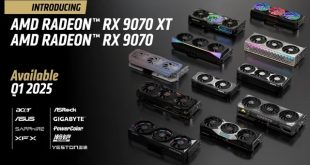AMD has submitted a new patch to AMKFD revealing the L1, L2, and L3 cache specifications of the Navi 23 GPU, the upcoming Ryzen “Van Gogh” APUs, and the “Aldebaran” Compute Accelerator.
The last note added by AMD to the AMKFD (via @Kepler_L2), a Linux HSA kernel driver for AMD APUs and GPUs, informs us that “L1 cache information has been updated and the L2/L3 information has been added” for Vega10 and newer ASICs. As you scroll down through the file, you'll see the cache information of various GPUs already available, but there are also three entries for unreleased chips. Those three are the Dimgray Cavefish/Navi 23 GPU, the Van Gogh APU, and the Aldebaran GPU Accelerator.
32MB Infinity Cache on Navi23 and no IC on Van Gogh confirmed. pic.twitter.com/TdF6a0N1jc
— Kepler (@Kepler_L2) March 29, 2021
Dimgray Cavefish GPU cache information appears just after the Sienna Cichlid (Navi 21) and Navy Flounder (Navi 22) segments of the file. Although there's no mention of “Infinity Cache”, the L3 cache sizes of the Navi 21 and 22 GPUs listed in the file match their Infinity Cache specifications. Considering this, we can only assume that the L3 cache is Infinity Cache, which means the Navi 23 GPU should come with 32MB of Infinity Cache.
Aldebaran and Van Gogh codenames are also mentioned in the file. Given that Aldebaran is supposed to be the successor to the MI200 GPU Accelerator, it comes as no surprise that it won't feature any Infinity Cache. As for the Van Gogh APUs, despite being the first APUs to feature RDNA graphics, they also seem to lack it.
KitGuru says: The Navi 23 GPUs are expected to power entry-level graphics cards, so 32MB of Infinity Cache might be enough to offer decent performance for 1080p gaming. Do you think 32MB of Infinity Cache is enough for entry-level gaming graphics cards?
 KitGuru KitGuru.net – Tech News | Hardware News | Hardware Reviews | IOS | Mobile | Gaming | Graphics Cards
KitGuru KitGuru.net – Tech News | Hardware News | Hardware Reviews | IOS | Mobile | Gaming | Graphics Cards


